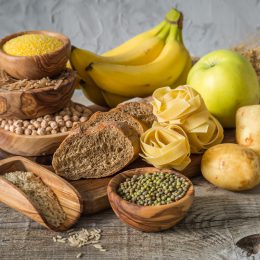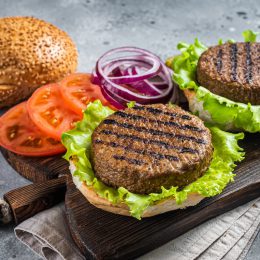The DASH Diet: Is It Right for You?
This flexible eating plan is designed to lower blood pressure and boost heart health. Here’s how it works.

You probably know at least one person with high blood pressure. You might even have it yourself. The condition, also known as hypertension, affects nearly 75 percent of people ages 60 and over, according to the Centers for Disease Control and Prevention (CDC).
Left uncontrolled, high blood pressure can damage blood vessels throughout the body and lead to serious health conditions, such as heart attack, stroke, or eye problems. That’s why scientists were inspired to design an eating plan to help reduce it: It’s called the DASH diet, which stands for Dietary Approaches to Stop Hypertension.
What Is the DASH Diet?
DASH is more of a heart-healthy, flexible eating plan than a rigid diet, says Leslie Bonci, R.D., the owner of Active Eating Advice in Pittsburgh, Pennsylvania.
There are no off-limit foods, special shakes to drink, or points to tally. Instead, DASH provides daily and weekly nutrition goals built around limiting salt, sugar, and saturated fat while packing in key nutrients that help lower blood pressure, such as potassium, calcium, and magnesium. When it comes to your grocery list, that means:
- Stock up on: Vegetables, fruits, and whole grains
- Also buy: Fat-free or low-fat dairy products, fish, poultry, beans, nuts, and vegetable oils (canola, corn, olive, and safflower oils)
- Limit: Sugary drinks, sweets, and foods high in saturated fats, such as red meat, full-fat dairy, and tropical oils (coconut, palm kernel, and palm oils)
These basic guidelines alone promote a heart-healthy diet, Bonci says. But if you’re truly following the DASH eating plan, you’ll also aim to hit target daily servings from different food groups, depending on how many calories you need each day.
For example, say you’re a moderately active adult in your 60s or older. According to the 2020 Dietary Guidelines for Americans, you need to eat about 1,800 calories per day. Here’s what your target servings would look like on the DASH eating plan:
Daily
- 6 servings of whole grains (whole grain bread or pasta, brown rice, oats, quinoa, unsalted popcorn
- 4 to 5 servings of vegetables
- 4 to 5 servings of fruit
- 2 to 3 servings of fat-free or low-fat dairy (fat-free or low-fat milk, yogurt, cheese)
- 6 ounces or less of lean meats, poultry, and fish
- 2,300 milligrams (1 teaspoon) or less of sodium
Weekly
- 4 servings of nuts, seeds, and legumes
- 2 to 3 servings of fats and oils (soft margarine, vegetable oil, low-fat mayonnaise)
- 5 or less servings of sweets and added sugars (jelly, maple syrup, candy, sugar)
The key takeaway: The DASH diet doesn’t eliminate any entire food group, but it provides a framework that “cautions you to choose wisely,” says Catherine Champagne, Ph.D., R.D.N., professor at Pennington Biomedical Research Center in Baton Rouge, Louisiana, and one of the lead developers of the diet.
Add SilverSneakers to your wellness routine. Classes and events are happening right now at participating gyms, online through SilverSneakers LIVE, and at community centers near you. Activate your free online account to get started.
The Health Benefits of the DASH Diet
The DASH Diet was designed to lower blood pressure, and numerous studies confirm it can help do exactly that.
One landmark study published in the New England Journal of Medicine found when people with hypertension (defined as having a systolic pressure above 140 mmHg; diastolic pressure above 90 mmHg; or both) followed the DASH diet for eight weeks, their systolic blood pressure dropped 11.4 mmHg and diastolic blood pressure dropped 5.5 mmHg.
“In people who had high blood pressure, the lowering effects [of the DASH diet on blood pressure] were equivalent to drugs that were on the market,” Champagne says. What’s more, the DASH diet was particularly effective for older adults, or those ages 55 to 65, she says.
In addition to lowering blood pressure, research links the DASH Diet to reducing total and LDL (“bad”) cholesterol levels, along with the risk of developing heart disease or experiencing a stroke. This makes sense, given the diet’s emphasis on limiting salt and saturated fat—both of which can be detrimental to heart health.
Possible Drawbacks of Following the DASH Diet
There aren’t many drawbacks to the DASH diet. People who prefer a more regimented plan—one with a set menu or list of foods—may have trouble figuring out what to eat, though the flexibility is appealing to most, Bonci says.
One other thing to consider: If you aren’t used to eating eight to 10 servings of produce each day, start with five or six servings total and gradually increase over the course of two weeks. Adding too many high-fiber foods to your diet too soon can cause gas, bloating, and diarrhea.
Ready to Try the DASH Diet? Start Here
Unlike many rigid or restrictive diets, “DASH is something you can follow for the rest of your life,” Champagne says. You may eat a few more or less of the recommended servings on some days, and that’s fine. Aim for the average of several days or one week to be close to the recommendations. And stay within the daily limit for sodium as much as possible.
Subscribe to our newsletter
It's quick and easy. You could be one of the 13 million people who are eligible.
Already a member? Click to discover our 15,000+ participating locations.
Follow Us
If you want to give it a shot, adopt these strategies for a smooth transition.
1. Eat some fruit at breakfast. It can be hard to eat eight to 10 servings of produce a day, Bonci says. By eating fruit in the morning (a banana with your cereal or berries with yogurt, for example), you aren’t scrambling to meet your quota later in the evening.
2. Make vegetables the main course. “The DASH diet is more reflective of what many other countries in the world eat,” Bonci says. More specifically, “meat is looked upon as the side, and produce, grains, or legumes are offered more space on the plate.”
3. Buy DASH-friendly prepared foods. Frozen and canned foods can be high in sodium, but fresh, prepared foods at your local supermarket, such as roasted vegetables or mini roasted potatoes, can still save you from having to whip up a meal from scratch.
Activate Your FREE SilverSneakers Online Account
Get hundreds of free SilverSneakers On-Demand videos and stay in touch with us by creating your free online account. You don’t have to be a SilverSneakers member to get on-demand workout videos, health and fitness tips from SilverSneakers, and more.
SilverSneakers members can go to thousands of nationwide gyms and fitness locations, plus take SilverSneakers LIVE online classes led by specially trained instructors and designed for all fitness levels and abilities – at no additional cost. If you have a Medicare Advantage plan, it may include SilverSneakers. Check your eligibility here.
Already a member? Get your SilverSneakers member ID, search for locations near you, and all the health and wellness resources you need by logging in to your online member account here.





